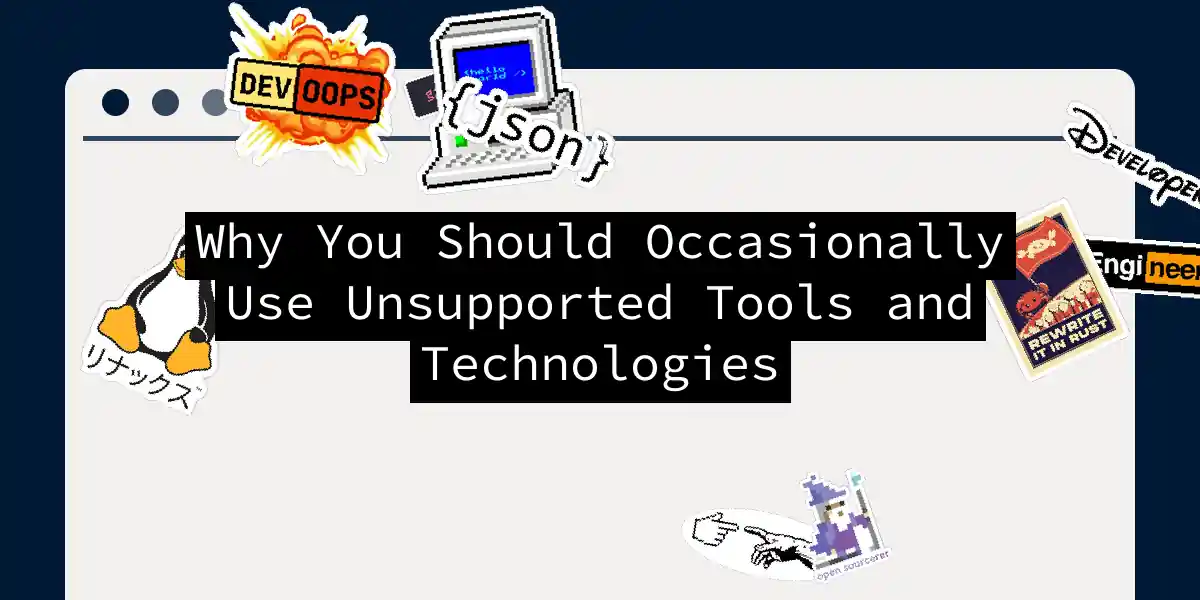The Double-Edged Sword of Unsupported Tools
In the fast-paced world of software development, the allure of the latest and greatest technologies is hard to resist. However, there’s a often-overlooked aspect of our tech arsenal that deserves some attention: unsupported tools and technologies. While the consensus is that using unsupported software is a recipe for disaster, there are scenarios where it might just be the right ingredient in your development soup.
The Benefits of Experimentation
Unsupported tools can be a treasure trove for innovation. Here’s why:
Cost-Effectiveness
One of the most significant advantages of using unsupported tools is the cost factor. With no licensing fees or subscription costs, developers can experiment freely without breaking the bank. This is particularly beneficial for startups or small projects where budget constraints are a major concern.
Community Support
Even though the official support might have ended, many unsupported tools still have vibrant communities around them. These communities often provide extensive documentation, forums, and networking opportunities that can be just as valuable as official support. For instance, older versions of open-source application servers might still have active communities that can help you troubleshoot and optimize your application.
Accelerated Learning
Using unsupported tools can be a great way to learn about the evolution of technology. By working with older systems, developers can gain a deeper understanding of how things were done in the past and how they have improved over time. This historical context can be invaluable in making informed decisions about current and future projects.
When to Use Unsupported Tools
Prototyping and Proof-of-Concept
Unsupported tools can be perfect for quick prototyping and proof-of-concept projects. Since these projects are often short-lived and don’t require long-term support, using older technologies can save time and resources. Here’s a simple flowchart to illustrate the decision process:
Legacy System Maintenance
Sometimes, you might need to maintain or update legacy systems that are still critical to your business operations. In these cases, using unsupported tools might be the only viable option. Here, the key is to manage the risks associated with these tools carefully.
Managing the Risks
Security Vulnerabilities
One of the most significant risks of using unsupported tools is security vulnerabilities. Since these tools no longer receive updates or patches, they can become easy targets for hackers. To mitigate this, it’s crucial to implement additional security measures such as firewalls, intrusion detection systems, and regular security audits.
Compliance and Regulatory Issues
Using unsupported tools can also lead to compliance and regulatory issues. For example, if your application handles sensitive data, using an unsupported database might violate data protection regulations. It’s essential to assess these risks and ensure that your use of unsupported tools does not compromise your compliance obligations.
Performance and Compatibility
Unsupported tools can also lead to performance issues and compatibility problems. As newer technologies advance, older systems may become incompatible with new hardware or software. This can result in system crashes, downtime, and decreased productivity.
Real-World Examples
Adobe Flash
Adobe Flash is a classic example of an unsupported technology that still has its uses. Although Adobe discontinued Flash in 2020, it is still used in certain niches such as legacy game development or educational content. Developers who need to maintain or update Flash-based content have to navigate the risks associated with an unsupported technology while leveraging its unique capabilities.
Older Operating Systems
Sometimes, older operating systems are still necessary for running specific software or hardware. For instance, certain industrial control systems might only be compatible with older versions of Windows. In these cases, using unsupported operating systems is a necessity, but it requires careful management of the associated risks.
Conclusion
Using unsupported tools and technologies is not a one-size-fits-all solution, but it can be a valuable strategy in certain scenarios. Whether you’re prototyping a new idea, maintaining legacy systems, or leveraging the unique capabilities of older technologies, the key is to be aware of the risks and manage them effectively.
So, the next time you’re tempted to dismiss an unsupported tool outright, remember that sometimes the old can be the new cool. Just make sure you’re wearing your cybersecurity helmet and have a solid plan in place to mitigate the risks.
And as the saying goes, “well-behaved code never makes history,” but using unsupported tools just might.
